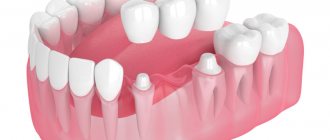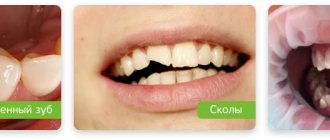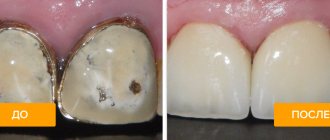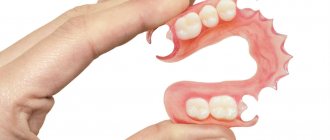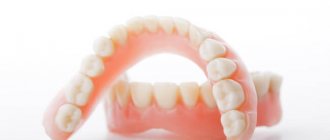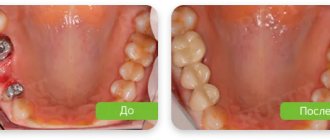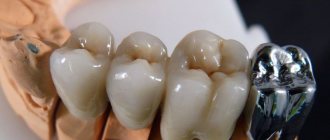From this article you will learn:
- which crowns are best for teeth,
- service life of crowns, guarantee for crowns,
- Which is better – a crown or an implant or a filling.
The choice of dental crowns for dental prosthetics usually occurs between metal-ceramics and metal-free ceramics. However, if the patient makes a choice in favor of metal-ceramics, the dentist immediately offers to choose its options. This can be either standard metal ceramics or highly aesthetic metal ceramics with the so-called “shoulder mass”.
The situation is similar with metal-free ceramics. Ceramic crowns can be made from different types of ceramic, such as zirconia or Emax glass ceramic. Which crowns are best to put on teeth will depend on many factors, for example, whether it is a front or chewing tooth, whether only single crowns or a bridge are needed, as well as on how high the patient’s aesthetic requirements are, and the size of your budget.
Prosthetics of chewing teeth: before and after photos
Clinical cases 1 and 2 –
The choice of the optimal type of crown for the front and posterior teeth will be different. Therefore, if you are more interested in prosthetics of the front teeth, read more about this in the article at the link below.
→ Which crowns are best for the front teeth?
Metal-plastic crowns
Such prostheses are called conditionally temporary crowns. A cost-effective prosthetics option that involves installing crowns with a metal base and a plastic coating. Traditionally, structures are made of nickel, cobalt, and chromium.
Despite the natural appearance and relatively good functionality, it is not worth wearing such prostheses for a long time: the product quickly loses its whiteness, slightly increases in size and needs to be replaced.
Among the undeniable advantages of metal plastic are its low cost and gentle effect on the enamel layer of the tooth. If the product is slightly deformed, it can be repaired directly in the patient’s mouth. Among the disadvantages of this choice, it is worth highlighting the low strength of the structure and the likelihood of developing allergies.
What are the consequences of untimely crown replacement?
1. Destruction of the tooth under the crown with its subsequent loss.
The main function of a crown is to restore a badly damaged tooth and protect it. The first time after installation, the crown performs its function perfectly. But after a certain time, changes occur. The gingival margin rises, saliva and gingival fluid affect the cement that “secures” the crown. Over time, this cement can be partially washed out (dissolved), a microscopic gap is formed between the crown and the tooth, and the tooth begins to deteriorate under the influence of microbes and oral fluid. The most insidious thing is that these signs occur asymptomatically and unnoticed by the patient, since they are painless. Therefore, replacement of crowns often occurs untimely, when the tooth is destroyed too much and becomes simply unreliable.
Associated with this is the myth that teeth under crowns are destroyed. The truth is that crowns are simply replaced at the wrong time, but too late.
This can be prevented by timely replacement of the orthopedic structure.
2. Inflammation of the tissues around the crown . This means the gums, tooth ligament and bone tissue. A poor-quality crown can lead to the formation of a chronic inflammatory process in the gums (gingivitis, periodontitis), which is manifested by redness, bleeding when brushing teeth, aching pain in the gums and an unpleasant odor. If such a crown is not replaced for a long time, the underlying tissues become involved in the inflammatory process, which may lead to the formation of bone pockets, disruption of the ligamentous apparatus of the tooth, and local periodontitis, which in severe cases leads to tooth loss.
Photo 2.1. Inflammation of the gums near teeth under crowns, associated with inaccurate marginal fit of the crown to the tooth and with a violation of the biological parameters of tooth restoration.
Important! Make it a rule to visit the dentist for a preventive examination at least once a year, if you have any dentures, in order to notice their failure in time and prevent or correct the problem.
Metal-ceramic crowns
Practice shows that metal-ceramic crowns are deservedly considered the most popular. The base of the product is metal (cobalt, chromium, titanium, gold, etc.). To give the crown an aesthetic appearance, the metal base is covered with a ceramic layer and the elements are connected by exposure to high temperatures.
The popularity of metal ceramics in prosthetics is explained by its obvious advantages:
- Aesthetics. The material with which the crown frame is covered completely recreates the anatomical structure of the enamel;
- Sufficient strength. The products are quite durable due to the cast metal frame - they can withstand normal chewing loads and do not wear out. It is rare to see chipping of the enamel coating. In this case, repair of the prosthesis can be done in the patient’s mouth;
- Versatility. Crowns of this type are installed both on individual fragments of a row, and in the form of a dental bridge.
Since the ceramic layer is completely opaque, the prosthetic fragment (especially with a single restoration) can stand out against the background of natural teeth. Another disadvantage of metal-ceramic crowns is the need to grind the unit, after which it forever loses its original shape.
Patient reviews
Dental problems started during pregnancy. Then there was a period of lactation, at the end of which I was left without two front teeth. At the clinic, an orthopedic dentist recommended making a metal-ceramic prosthesis. It didn’t suit me at all, they adjusted it four times, but to no avail. Then they replaced it with zirconium crowns. I've been using them successfully for three years now. I am no longer ashamed of my smile, but, on the contrary, proud of it.
Natalya, 34 years old
After caries treatment, I was left without one front tooth. The situation for a person who works with people is not the most pleasant. In my case, there was no doubt; I immediately chose prosthetics with zirconium crowns. In my opinion, this prosthesis is the most successful, although not cheap. Adaptation went quickly, no discomfort arose, and the smile remained the same; outwardly, the artificial incisor cannot be distinguished from the real one. I believe that only zirconium is suitable for restoring front teeth.
Alexander Sergeevich, 42 years old
Several years ago I had metal-ceramic crowns installed.
I was very pleased with the prosthesis, nothing interferes, my teeth are still in excellent condition. Many people were afraid that my gums would turn blue, but nothing like that happened in my case. I eat whatever I want, even hard apples, but no chips have arisen during this time. So I recommend this option to everyone I know. Angelina
Metal crowns
These are the predecessors of all other types of dentures. This type of prosthesis is indicated for installation only on chewing teeth, since the structures are noticeable on the front teeth. Metal crowns are made of steel, titanium, platinum, and gold. Alloys containing cobalt, chromium, and silver are also in demand.
In laboratory conditions, stamped or cast products with spraying are prepared for patients. Standard structures take on the desired shape as work progresses. Individual production of the cap guarantees maximum adherence to the tissues, which eliminates rapid abrasion of the material and the spread of bacteria under the prosthesis.
Among the advantages of such products, it is worth noting their exceptional strength (due to the plasticity of the material, a crown made of this type of material does not crack and does not wear out for a long time). However, metal dentures are extremely unaesthetic, can cause allergies, and are difficult to fit on a tooth.
In addition, when using metal prosthetics, it is worth considering that crowns made from several types of metal cannot be used at once. If the patient already has a steel structure in his mouth, in the future he will have to fix crowns only from this material. Otherwise, the patient may develop galvanic syndrome, which is manifested by a burning sensation in the mouth and a “metallic” taste.
Can the patient himself understand that it is time to replace the crown?
Certainly! There are a number of signs, the presence of which should give cause for concern.
- The most common is crown edge exposure , when the gingival margin rises and the tooth root becomes visible (“gingival recession”). In this case, root caries may develop, that is, the tooth may be destroyed.
Photo 2.2. The initial stage of exposure of the roots of the teeth under the crowns.
Photo 2.3. The advanced stage of exposure of the roots of the teeth under the crowns.
- Inflammation of the gums around the crown , which manifests itself in redness of the gums, swelling, and bleeding when brushing.
Photo 2.4. Inflammation of the gingival margin of teeth under crowns, associated with inaccurate marginal fit of the crown to the tooth and with a violation of the biological parameters of tooth restoration.
- The appearance of crown mobility . Patients often say that the crown or bridge is “fixed.” This happens especially often when several crowns are combined (some of the crowns of the bridge have become uncemented, while the rest are still holding together).
- The appearance of an unpleasant odor or taste in the crown area.
- Food getting stuck between crown/crown and tooth.
Important! All of the above signs are a mandatory reason to visit the dentist.
Ceramic crowns for teeth
Metal-free crowns are deservedly recognized as the most aesthetic: they are extremely difficult to distinguish from natural teeth, even if the gum tissue becomes thinner, the prosthesis remains invisible and looks natural. In dentistry, several types of metal-free dental crowns are used:
- Porcelain or all-ceramic. They are made according to a personal impression from pressed material without adding other components.
- Mixed (zirconium dioxide and ceramics). They are stronger than the previous type of prosthesis, have high light transmittance and do not cause allergies.
- Mixed (aluminum oxide and ceramics). The designs are made of translucent hypoallergenic material, which is comfortable to wear and resistant to temperature changes.
All ceramic products are biologically compatible with mucous membranes and do not tend to cause allergic reactions. Other advantages of the designs include:
- light weight (a crown can be installed even on weakened teeth);
- immunity of ceramics to dyes;
- the need for minimal tooth grinding before ceramic prosthetics.
The disadvantages of this method of prosthetics include the relatively high cost of the products, as well as their fragility. Ceramic structures are not designed for significant chewing loads, which is why they are more often used for prosthetics of the upper incisors.
If you properly care for ceramic products, they will last from 10 to 15 years. At the same time, the prosthetic structure is not susceptible to caries and does not accumulate plaque.
Comparative characteristics of the best crowns
To determine which crowns are the best , you need to study the pros and cons of each product, taking into account the material used.
Next, we will compare the key parameters of various prosthetic options:
| Crown | pros | Minuses |
| Made from metal-ceramics using precious metals | Has increased strength, has a natural appearance, does not cause allergization of the body | High price |
| Made from metal-ceramics using non-precious metals | It is famous for its sufficient strength, has a reasonable price and good aesthetic parameters | There is a possibility of allergy |
| Made of ceramic material | Features impeccable aesthetic parameters and absolute compatibility with the patient’s body | Increased fragility |
| Made of zirconium material | Excellent aesthetic properties, long period of operation, absolute compatibility with the body, absence of allergic reactions | Impressive value |
| e.max crowns | Unsurpassed aesthetics, increased strength, excellent light transmittance. Emax Press has a gradient of color and transparency. | High price. Only single crowns can be installed in the chewing region. |
Zirconium dioxide crowns
Zirconium crowns are prepared in laboratory conditions using high-precision computer equipment. Laser scanning allows for an accurate analysis of the dentition, after which a computer program models an accurate crown for the tooth. Optical data is transferred from the computer to a milling machine, which grinds the prosthesis from the workpiece.
These types of dental crowns are the most expensive. Their price is justified by a number of obvious advantages:
- Strength. Zirconium dioxide is as durable as natural tooth enamel. Even solid bridges can be made on the basis of this material;
- High aesthetics. The shade of zirconium dioxide can easily be matched to the color of the natural enamel layer;
- Biological compatibility. Zirconium dioxide is safe for human health. This type of prosthetics is not contraindicated for patients with metal allergies.
The products are recommended for installation by patients who have high demands on the appearance of structures and want their new teeth to be indistinguishable from natural elements.
Alternative options to frontal crowns
At the moment, there are three alternative methods that allow you to restore the crown part of the tooth, with destruction of no more than 50%. These include:
- Veneers. Suitable for use if there is slight destruction of the outer surface of one of the front teeth. An important requirement for carrying out a procedure using such plates is the preservation of the tooth wall from the inside. Through veneers, unsurpassed aesthetics are achieved, the possibility of tooth preservation is ensured and it is possible to significantly extend the life of the tooth;
- Dental implants. If it is necessary to reconstruct 1-2 teeth and install bridge-like prosthetic devices, it is advisable to fix the implants instead of preparing the supporting units;
- Filling material. As mentioned earlier, the option with light-composite restorations is preferable when the coronal part of the tooth is destroyed by no more than 50%.
Gold crowns on teeth
Separately, it is worth noting the type of metal crowns - gold products. In dentistry, pure material is not used in the manufacture of dentures, since gold is a soft metal. Traditionally, an alloy with palladium and platinum is used. The structures fit well, do not irritate the mucous membrane, and do not lead to bleeding gums.
Very often, gold dentures are coated with a ceramic layer. Such products can even be placed on the front teeth: they retain the beneficial properties of the base material and look good.
Main features of metal-ceramic prostheses
This type of prosthesis is a type of solid cast structure; it consists of a metal base (frame) with ceramic lining. It is created from special alloys (zirconium dioxide, cobalt/chrome or nickel/chrome) designed specifically for dental needs. Sometimes alloys containing precious metals (gold, silver, palladium) are used to make the base. Depending on what metals the metal ceramics contain, the price of prostheses may vary.
Temporary crowns on teeth
Since dental prosthetics requires time, the patient is often given temporary crowns. The patient wears the dentures until the permanent dentures are ready.
We are talking about inexpensive polymer, acrylic, and plastic crowns, which are designed to protect the prepared units from displacement and pathogens. In addition, they perfectly perform an aesthetic function, masking “holes” in the oral cavity.
Temporary crowns can be placed on natural teeth or on implants. Due to these structures, an even distribution of the chewing load is ensured, the risk of jawbone resorption is reduced, and the rate of adaptation to a permanent prosthesis is accelerated.
Where to go for dental care in Ivanteevka and Shchelkovo?
If you need a crown, bridge, or implantation services, contact Sanident Comprehensive Dentistry. Our patients have the opportunity to receive a free consultation and undergo treatment at the most affordable price.
Dental prosthetics is one of the dental services provided by the clinic’s specialists at a high level.
Diagnostics and treatment are carried out using modern equipment, using high-quality raw materials. We provide a guarantee for all types of services.
Ranking of dental crowns by nomination
| The most | |
| Aesthetic | Unaesthetic |
| Zirconium | Metal |
| Durable | Short-lived |
| Zirconium/Metal | Metal-plastic |
| Biologically compatible | Unsafe for the body |
| Zirconium/Ceramic/Metal-ceramic with gold-platinum alloy frame | Nickel-based metal-ceramic |
Smile zone: indications for installing crowns
When communicating and expressing emotions, the teeth in the frontal region are involuntarily exposed. Their condition is visible to others, and this can cause psychological discomfort. If you are not happy with the appearance of your front incisors, contact your dentist. Even in the most advanced cases, when teeth are severely damaged, it is not necessary to remove them. After a thorough diagnosis, the doctor may recommend restoring teeth with crowns. A cap-like structure is placed over the remaining part of the tooth and takes over its functions.
What dentures are best for the front teeth?
Since the teeth in the smile area are visible to others, high aesthetic demands are placed on prosthetics in this area. In this regard, it is better to install prostheses made of zirconium dioxide (aluminum oxide), metal ceramics or all-ceramic crowns on the front teeth.
Caps made of solid ceramics are put on the upper incisors; they look good and are not subject to heavy loads. Products are made from medical porcelain using injection molding.
The lower incisors and canines bear a significant load, so in this case, solid ceramics are replaced with zirconium dioxide. The durable frame is coated with a ceramic layer to create a reliable and attractive prosthesis for the front teeth.
In addition, zirconium dioxide is successfully used when installing dental bridges in the smile area.
When is it time to change?
The decision to replace the product can only be made by a specialist based on objective signs.
These include:
- the prosthesis or crown was installed a long time ago and its integrity is compromised;
- no clear fit;
- there are areas of plaque accumulation;
- the presence of signs of inflammatory nature, exposure of the root.
Specific symptoms will help you understand that it is better not to postpone a visit to a specialist.
It is necessary to change the design if:
- the tooth under the crown hurts;
- gums become inflamed;
- an unpleasant odor appeared;
- leftover food gets stuck;
- the system has become mobile;
- the lower jaw protruded forward, it became difficult to bite and chew food.
Postponing a visit to the dental clinic can cause a number of unpleasant consequences.
What is better to put on chewing teeth?
Since the chewing teeth bear the bulk of the load, the crowns on them must be strong. Most often, metal-ceramic crowns are placed in the lateral sections. Metal ceramics are durable and aesthetic, but require significant grinding of dental tissue.
Zirconium dioxide has proven itself to be excellent. Its strength is comparable to the strength of metal crowns; only zirconium prostheses, unlike metal ones, are very similar to natural teeth. Another advantage of this choice is the insignificant grinding of tooth enamel before prosthetics.
All-metal crowns on teeth are cheaper. They have a long service life and are resistant to corrosion. An even more significant disadvantage of such prostheses (in addition to the low level of aesthetics) is the risk of developing an allergy to the material.
Contraindications for installation
To place a crown on a tooth, you need to take into account not only the indications, but also the contraindications. Absolute contraindications include:
- healthy (intact) teeth; the exception is the situation when they are used as a support for other orthopedic prostheses;
- high pathological tooth mobility;
- chronic foci of infection of dental tissues that cannot be treated.
Relative:
- insufficient oral hygiene, caries - prosthetics are carried out after complete sanitation of the oral cavity;
- destruction of the crown by more than half - if the root is preserved, prosthetics are carried out after the pin is installed;
- destruction of the tooth root with its subsequent removal - prosthetics after implantation of a titanium root;
- chronic periodontitis (inflammation of the ligament that holds the tooth in the cell) - prosthetics after complete elimination of the causes of the disease - cysts, fistulas, etc.;
- not fully formed dental roots;
- severe general diseases - high blood pressure, stroke, myocardial infarction - prosthetics are possible after stabilization of the patient’s general condition.
Duration of operation of different types of crowns
The most short-lived structures are made of metal-plastic. Therefore, they are traditionally used as temporary crowns. The maximum service life of products is 5 years. According to patient reviews, over time the plastic coating deforms and darkens.
Metal-ceramics is a practical option that is installed on both the front and chewing teeth. Such structures last up to 10 years.
Crowns made of medical porcelain do not darken or fade and can last up to 10-15 years. Throughout this period, the product looks like a natural tooth.
Crowns made of zirconium dioxide are considered even more stable: their service life is 15-20 years.
Prostheses made from precious metal alloys and products made from nickel are also durable and can last up to 15 years.
The service life of different types of crowns depends not only on the material, but also on the accuracy of installation. There should be no voids or gaps under a well-fixed crown. Otherwise, food debris will accumulate under the product, which over time will lead to the development of an inflammatory prosthesis.
How long does the procedure take?
The duration of the procedure depends on the type of dental crown and the wishes of the patient. Usually several visits to the dentist are required. During the first visit, the doctor will conduct a consultation and refer the patient for an x-ray. After this, impressions of the teeth will be made, and then dentures. The duration of one session depends on the complexity of the work and the number of crowns; on average, the patient has to spend 1-2 hours in the dental chair.
It is important to know. The durability of crowns largely depends on the quality of the dentist’s work. Therefore, choosing a clinic must be approached very responsibly.
How to properly care for crowns
The method of caring for crowns is practically no different from the principles of caring for natural teeth and involves:
- performing oral hygiene twice a day (not only the teeth, but also the tongue should be brushed);
- cleaning the spaces between teeth and the space under dentures. To ensure the proper level of hygiene, it is preferable to use an irrigator: a directed jet helps to quickly and painlessly clean the space under the product;
- nutrition correction - excluding too hard foods and temperature changes from the menu;
- monitoring the condition of the gums and areas where teeth meet crowns (this is where caries most often develops);
- using mouth rinses after each meal (special formulations can be replaced with plain water).
Dentists also advise periodically massaging the gums under the structure. Soft tissues undergo increased pressure, so it is important to stimulate blood circulation in these areas. The gums should be massaged with smooth circular movements clockwise and counterclockwise.
Features of care
Teeth with crowns do not require special care. But the patient should not forget about maintaining hygiene at the proper level. It is necessary to brush your teeth at least twice a day and rinse your mouth with bactericidal solutions. You should also follow simple recommendations:
- do not allow strong temperature changes in the oral cavity;
- do not test the strength of artificial teeth by trying to bite through nuts and other hard objects;
- carry out professional cleaning at the dentist at least once every 6 months;
- limit the consumption of coffee, strong tea, and sweets.
How much does it cost to install a crown on a tooth?
The key criterion that determines the cost of prosthetics is the material used to make the prosthesis. If you arrange them from cheapest to most expensive, the list will look like this:
- metal-plastic;
- metal;
- gold;
- metal ceramics with ordinary metals;
- metal ceramics on a gold base;
- ceramics;
- zirconium dioxide.
In addition to the material, the price of the prosthesis is also influenced by the pricing policy of the clinic, the equipment used, and the qualifications of the attending physician. Some clinics manage to save money on prosthetics by installing crowns on several teeth at once.
It is impossible to accurately answer the question of which crown is best to install. The doctor makes the decision together with the patient. When choosing, emphasis is placed on clinical indications, characteristics of the patient’s jaw system, the state of oral health in general, the wishes and financial capabilities of the person.
After prosthetics
- Before prosthetics, finally check the color and shape of the dental crowns in natural light. It’s better to go out into the hall and look in a regular mirror.
- Once fixed, it will be impossible to change the color.
- After fixing the crowns, try to spend some time in the clinic (for example, in the lobby), once again checking the structures in a more relaxed atmosphere.
- Ask your doctor about hygiene and special care practices.
- Ask for the doctor’s contact number (if necessary, ask questions by phone).
- Make an appointment with your doctor in 7 days for a follow-up examination, regardless of the condition of the crowns.
- Professional control is required after 7 days.
- If you experience any problems with your crowns, contact your dentist immediately.
Alternatives to a Dental Crown
Veneers are often preferred to crowns in the smile area. However, in this case, the back side of the elements should be more or less preserved.
Teeth can be restored using filling materials. This method can only be used if the destruction of the unit is not so global (less than half).
Judging by the reviews of doctors and patients, crowns are considered the optimal solution for significant damage to teeth, since they not only restore the functionality and aesthetics of a row, but also protect teeth from further destruction. An additional bonus of this type of prosthetics is the variability of materials and, accordingly, the cost of services.
Prosthetic options depending on the clinical picture
- If you need to correct the shape, size, color of incisors, fangs, eliminate cracks, small chips, a good solution is ceramic or zirconium veneers. Thin dental onlays (up to 0.3 mm) require minor preparation of the enamel layer. They are fixed to the outside of the teeth with composite glue (bond).
- If there is extensive destruction of the supragingival part ( more than 60%
), a dental crown is installed. Before installation, the incisor and canine are given the desired shape (grinded), the root is strengthened with a stump insert (if necessary), the prosthesis is fixed to the support with dental cement. - If not only the supragingival part is destroyed, but also the root, implantation will help restore full aesthetics and functionality of the dentition. If the clinical situation allows, the implant is immediately loaded with a temporary crown, which is replaced with a permanent one after the implantation of the artificial root.
Immediate prosthetics for single defects is possible only for incisors and canines (up to the 5th premolar). The prosthetic structure is removed from the bite (made slightly lower in height). This is necessary to eliminate the risk of loosening the implant due to the load on the prosthesis.
Restoration with crowns is indicated in the following cases:
- aesthetic defects (chips, stains, cracks, diastemas, trema, curvature, etc.);
- single or complete destruction of teeth with preservation of the root;
- uneven gum line;
- bite pathology;
- pathological abrasion and discoloration of enamel;
- restoration of lost functions (biting, sharing food, diction).
The front incisors are not associated with the chewing function, so there are no strict requirements for the strength of the crowns. The doctor’s task is to recreate the anatomical shape and color of natural teeth, maintain their degree of transparency, and achieve a perfect match of sizes.
